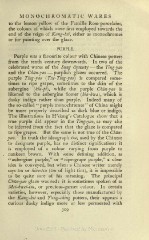Page 383 - Oriental Series Japan and China, Brinkly
P. 383
MONOCHROMATIC WARES
to the lemon yellow of the Famille Rose porcelains,
the colours of which were first employed towards the
end of the reign of Kang-hsi, either as monochromes
or for painting over the glaze.
PURPLE.
Purple was a favourite colour with Chinese potters
from the tenth century downwards. In two of the
celebrated wares of the Sung dynasty the Ting-yao
and the Chiin-yao purplish glazes occurred. The
purple Ting-yao (Tsu-Ting-yao} is compared some-
times to ripe grapes, sometimes to the skin of the
aubergine (kia-pi\ t while the purple Chiin-yao is
likened to the aubergine flower (kia-hwa} t which is
dusky indigo rather than purple. "InodfeCehdinmaanmyighotf
the so-called " purple
monochromes
be more properly described as dark blue or indigo.
The illustrations in H'siang's Catalogue show that a
true purple did appear in the Ting-yao, as may also
be inferred from the fact that the glaze is compared
to ripe grapes. But the same is not true of the Chiin-
yao. In truth the ideograph tsu, used by the Chinese
to designate purple, has no distinct signification : it
is employed of a colour varying from purple to
. nankeen brown. With some defining addition, as
" "
aubergine purple," or ripe-grape purple," a clear
idea is conveyed, but when a Chinese writer merely
says tsu or hiao-tsu (tsu of light tint), it is impossible
to be quite sure of his meaning. The principal
Chiin-yao glaze was red : it is sometimes spoken of as
Mei-kwei-tsu, or precious-garnet colour. In certain
varieties, however, especially those manufactured by
the Kang-hsi and Tung-ching potters, their appears a
curious dusky indigo more or less permeated with
309

